by Sheila Dunning | May 13, 2014
Last summer’s heavy rain and the stress of January’s icy weather have contributed to widespread outbreaks of Take-All Root Rot, a soil-inhabiting fungus Gaeumannomyces graminis var. graminis that causes yellow grass patches ranging in diameter from a few inches to more than 15 feet. The symptoms first appear in the spring, but disease can persist all summer and survive the winter. Over time the entire area dies as the root system rots away.
![[Click thumbnail to enlarge.]](https://edis.ifas.ufl.edu/LyraEDISServlet?command=getThumbnailImage&oid=10886581)
![[Click thumbnail to enlarge.]](https://edis.ifas.ufl.edu/LyraEDISServlet?command=getThumbnailImage&oid=9033591)
The pathogen is naturally present on warm-season turfgrass roots. High rainfall and stressed turfgrass trigger the disease. Because the roots are affected, they are not able to efficiently obtain water or nutrients from the soil, nor are they able to store the products of photosynthesis, which result in the loss of color in the leaves. By the time the leaf symptoms appear, the pathogen has been active on the roots for several weeks, probably longer; potentially years. If the turfgrass is not stressed, leaf symptoms may never be observed.
![[Click thumbnail to enlarge.]](https://edis.ifas.ufl.edu/LyraEDISServlet?command=getThumbnailImage&oid=6143337)
This disease is very difficult to control once the above-ground symptoms are observed. Measures that prevent or alleviate stress are the best methods for controlling the disease. Any stress (environmental or man-made) placed on the turf weakens it, making it more susceptible to disease. Remember, that every maintenance practice, fertilizer application, and chemical (especially herbicide), application has an impact on turfgrass health.
Cultural practices that impact the level of stress experienced by a lawn include: proper turfgrass species selection; mowing at the correct height; irrigation timing, frequency and volume; fertilizer nitrogen and potassium sources and application quantities; thatch accumulation; and soil compaction issues. The selection of turfgrass species should be based on existing soil pH, sunlight exposure, use of the area and planned maintenance level.
Mower blades must be sharp to avoid tearing of the leaves. Additionally, turfgrasses that are cut below their optimum height become stressed and more susceptible to diseases, especially root rots. When any disease occurs, raise the cutting height. Scalping the grass damages the growing point. Raising the cutting height increases the green plant tissue available for photosynthesis, resulting in more energy for turfgrass growth and subsequent recovery from disease. If an area of the lawn has an active fungus, washing or blowing off the mower following use will reduce the spread of the disease to unaffected areas.
The amount of water and the timing of its application can prevent or contribute to disease development. Most fungal pathogens that cause leaf diseases require free water (rainfall, irrigation, dew) on the leaf to initiate the infection process. Irrigating every day for a few minutes is not beneficial for the turfgrass because it does not provide enough water to the root zone, but it is beneficial for turfgrass pathogens. It is always best to irrigate when dew is already present, usually between 2 and 8 a.m., and then only apply enough water to saturate the root zone of the turfgrass.
Excessively high nitrogen fertility contributes to turfgrass diseases. The minimum amount required for the grass species should be applied. Potassium (K) is an important component in the prevention of diseases, because it prevents plant stress. Application of equal amounts of nitrogen and potassium is recommended for turfgrass health. When turfgrass roots are damaged from disease, it is beneficial to apply nutrients in a liquid solution. However, nitrate-nitrogen increases the severity of diseases, so their use should be avoided when possible. Ammonium-containing fertilizers are the preferred nitrogen sources. Heavy liming has also been linked to increases in Take-All Root Rot. Since most turfgrasses can tolerate a range of pH, maintaining soil at 5.5 to 6.0 can suppress the development of the pathogen. When the disease is active, frequent foliar applications of small amounts of nutrients is necessary to keep the turfgrass from declining.
Additional maintenance practices that need to be addressed are thatch removal and reduction of soil compaction. Excessive thatch often causes the mower to sink which can result in scalping and reducing the amount of leaf tissue capable of photosynthesizing. Thatch and compacted soil prevent proper drainage, resulting in areas remaining excessively wet, depriving root systems of oxygen.
Since recovery of Take-All – damaged turfgrass is often poor, complete renovation of the lawn may be necessary. Removal of all diseased tissue is advised. As a native, soil-inhabiting pathogen, Take-All-Root-Rot cannot be eliminated. But, suppression of the organism through physical removal followed by proper cultivation of the new sod is critical to the establishment of a new lawn. Turfgrass management practices, not chemicals, offer the best control of the disease.
It is acceptable to use fungicides on a preventative basis while rooting in the sod. Azoxystrobin, fenarimol, myclobutanil, propiconazole, pyraclostrobin, thiophate methyl, and triadimefon are all fungicides that can be utilized to prevent disease development while having to excessively irrigate newly laid sod. Ideally, the turf area should be mowed and irrigated prior to a fungicide application. Unless the product needs to be watered in, do not irrigate for at least 24 hours after a chemical treatment. Do not mow for at least 24 hours, to avoid removal of the product attached to the leaf blades.
Now that we have added another major stress with the recent heavy rain, it will be very important to continue monitoring the turf and being cautious about the cultural practices being used. Take-All Root Rot is likely to flourish. Do not encourage its development.
by Taylor Vandiver | Apr 29, 2014
Now that spring has finally sprung and summer is well on its way, you may find yourself taking a stroll through your landscape and assessing damage done by late cold spells. However, it may not be a frost problem that has your plants looking worse for the wear. They could be experiencing nutritional imbalances which affect overall plant health. Most cases involving nutrition issues in plants can be linked back to the soil. Therefore, if you suspect a problem I suggest testing your soil to ascertain pH and nutrient levels. You can obtain a soil test kit at your local UF IFAS Extension office. Another way to diagnose your plant damage is to visually catalog its symptoms. Symptoms of mobile nutrients, such as nitrogen and phosphorus, tend to reveal themselves on older leaves first. Whereas, immobile nutrient symptoms (i.e. boron and calcium) will show up on newer leaves. These flow charts can help to narrow down which essential element may be lacking in your plant’s diet.
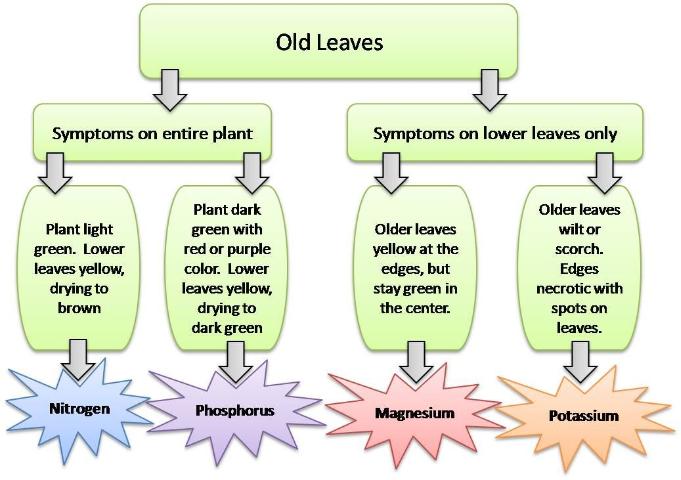
Mobile Nutrient Symptoms.
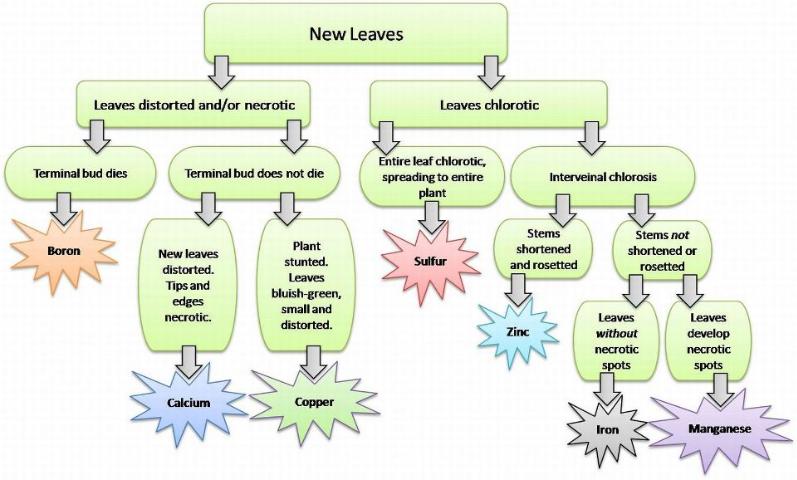
Immobile Nutrient Symptoms.
by Larry Williams | Apr 29, 2014
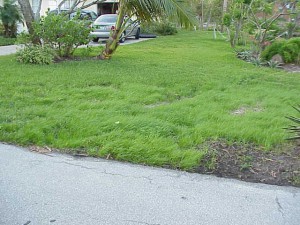
Kentucky bluegrass, Fescuegrass & ryegrass (annual ryegrass pictured) can be seeded to provide a temporary winter lawn but will not provide a permanent lawn in Florida due to our hot, wet summers. Photo Credit: Dan Culbert, UF/IFAS
If it sounds too good to be true, it probably is. This phrase offers sound advice for the person looking for the “perfect” lawn grass.
It’s common to see advertisements for the perfect lawn grass. You should be skeptical when reading advertisements that proclaim an amazing grass that produces a lush, green lawn with very little care. Question advertisements for grass seed mixtures that grow from Alaska to Florida. Beware of advertisements that do not include a specific name for the lawn grass being sold. Don’t believe advertisements that claim their grass even grows in impossible spots.
A number of years ago, I called a company that was advertising a grass seed mixture in hopes of finding out specifically what grass seeds were in this “too-good-to-be-true” mixture. I was told the seed mixture included Kentucky bluegrass, creeping red fescue and annual ryegrass. This information was not included in the advertisement. And it claimed that it would produce an attractive lawn for Florida.
In Florida, ryegrass, fescuegrass and Kentucky bluegrass will produce a green lawn during winter and early spring. However, as temperatures warm in late spring and summer, these grasses will die. All three are cool-season grasses that will not tolerate our hot, humid summer weather. They will not produce a permanent lawn in our area.
Basically there are seven types of grasses from which to choose when considering planting a lawn in Florida. Centipede and St. Augustine are the most commonly planted in our area. Bahia, bermuda, carpet, seashore paspalum and zoysia are used less often. All of these grasses have advantages and disadvantages, which should be looked at and understood before choosing a grass for your lawn.
With time, most people in our area will become frustrated with their lawn. As a result, North Florida is a great area to market a too-good-to-be-true lawn grass. It’s difficult to grow a lawn here. All of our lawn grasses are native to other parts of the world – they did not exist in our native ecosystem. Expectations for a Florida lawn are too high. Because of these factors, many people are looking for that too-good-to-be-true grass.
Be cautious before spending time and money on one of those “perfect” lawn grasses.
Contact the University of Florida Extension Office in your County or visit the following website for reliable information on lawn grass selection and maintenance for Florida. hort.ufl.edu/yourfloridalawn
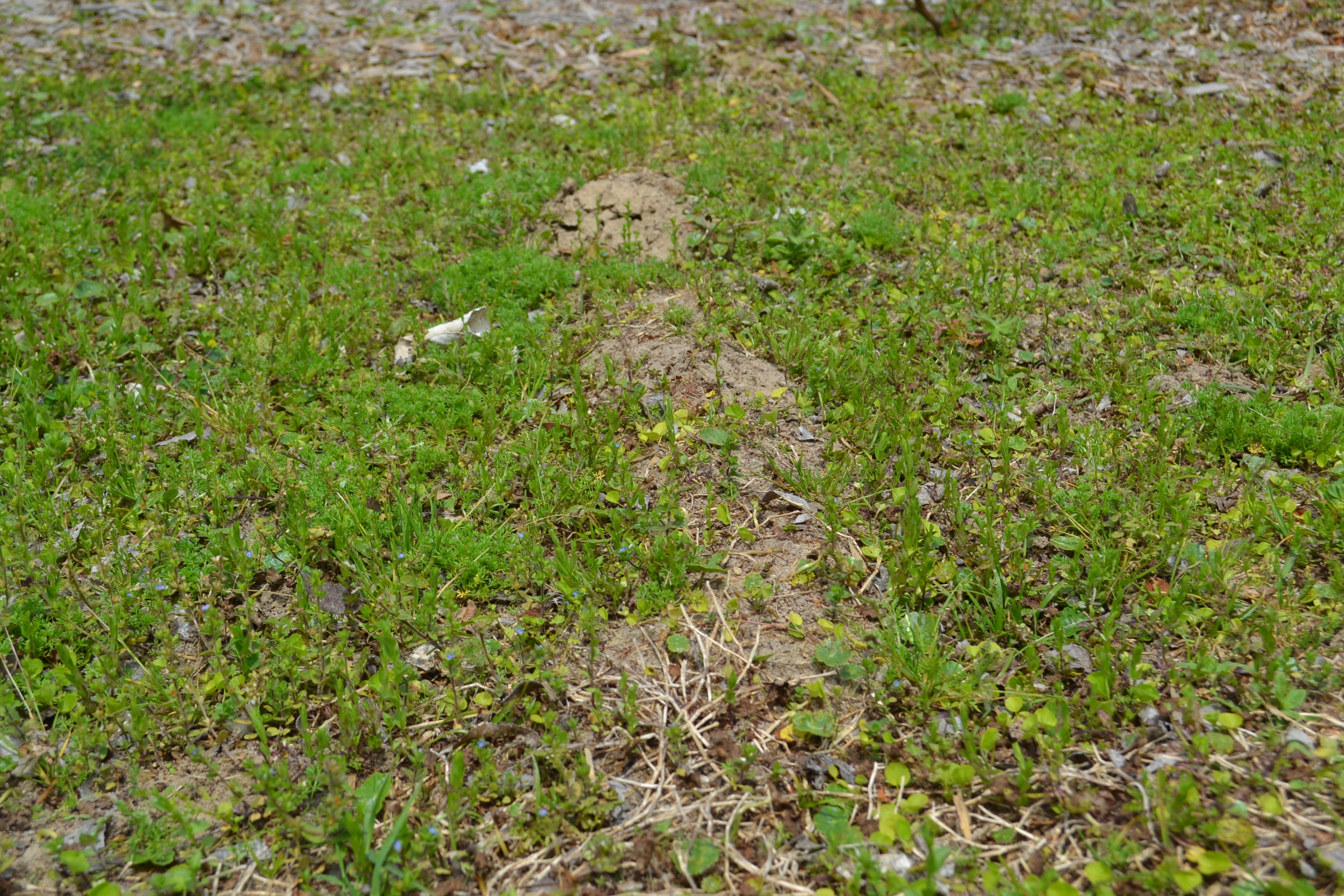
by Beth Bolles | Apr 15, 2014
How can an animal that does such much to help rid your lawn of pests be so hated by most homeowners? Such is the life of the mole.
The beneficial mammal is a soil dweller that tunnels through the soil, increasing aeration as it searches out a meal of beetle grubs, mole crickets, and slugs. Moles prefer loose soil and can tunnel more than 15 feet an hour. Moist soil brings the food source closer to the surface which in turn bring moles up to expose raised tunnels to homeowners. These tunnels are mostly cosmetic and show up easily in mulched areas and lawns with heavier weed populations. Most homeowners with a healthy, thicker lawn will rarely notice mole activity unless they encounter loose areas as they walk over the turf. These can easily be pressed back down with your foot.
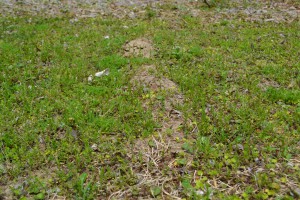
Mole tunnel in weedy area. Photo: Beth Bolles, UF IFAS Extension Escambia County
There are management techniques for moles which include traps and ridding the lawn of the food source. The best practices are to manage the turf through proper mowing, watering, and fertilizing to create a uniform, healthy cover. For the most part, mole management is not even required. Consider the benefits of the moles as predators and allow them to be a natural part of the landscape environment. For more information on moles read the University of Florida IFAS Extension publication.
by Les Harrison | Apr 8, 2014
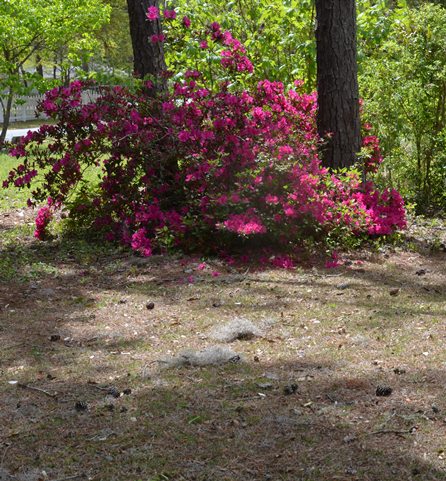
While the azaleas may be blooming, most north Florida Lawns still need some work to be ready for the growing season.
Spring is officially here, so this means it is time to get the lawn in shape for another growing season in north Florida. The first step is to develop an action plan which sets the path to achieving turf success.
A good starting point is mowing the lawn to get any leaves removed and trim any weeds which have emerged. Empty the bagged clipping in a compost pile for later use.
Shaded areas under trees must be treated differently since grass will not grow in those areas. Just leave the natural tree leaf mulch there and add additional mulch as needed.
If there are marginally shaded areas where turf is preferred, spring is a good time to plant some grass plugs. All southern turf grasses prefer full sun, but a few St. Augustine cultivars such as ‘Seville’, ‘Delmar’, and ‘Captiva’ will tolerate some shade.
Trying some plugs of ‘Seville’ St. Augustine is a low-cost way of determining if there is enough sunlight to grow grass. The plugs are available at local garden centers.
If the plugs don’t take hold and spread, then there is not enough sunlight. Use groundcovers, mulches, or other plantings in these shaded areas.
Before mowing, use a ruler to set the cutting level. Try to never remove more than one-third the length of the grass blade at any one mowing.
Sharpen the mower blades after every four to eight hours of mowing so a ragged cut is avoided. Maintain St. Augustine grass at about three inches tall and centipede at about one and one-half inches.
Most of the weeds currently in panhandle Florida lawns are winter annuals. They are flowering and will soon go to seed, then die as the weather gets hotter.
It is difficult to kill these winter annuals at this mature stage, so applying herbicide now is pointless. The best option is to keep the weeds mown so they do not produce as many seed and reemerge next year. Also, apply a pre-emergent herbicide in October 2014 to minimize 2015’s spring weeds.
Now is the time to put out a pre-emergent herbicide for some of the summer weeds, particularly chamberbitter.
Unless a soil test indicates a need for phosphorus, the best fertilizers to use on lawns will be missing this nutrient. The commonly available 15-0-15 fertilizers should also have half of the nitrogen (7.5%) in a slow-release form.
Many local retailers have these 15-0-15 fertilizers with and without herbicide. Generally speaking apply the 15-0-15 fertilizer without herbicide. Below is a table of recommended fertilizer application rates based on typical lawn square footage.
Table 2. Recommended application rates for turfgrass fertilizers to Florida lawns: 15–30 percent slow-release nitrogen. From Publication #ENH979
| Use this table to match the size of your lawn to the percentage of nitrogen (N) in your fertilizer to find the amount of fertilizer you need to apply. If you have a bahiagrass lawn, apply this amount of fertilizer about four times a year no matter where you live in the state. For centipedegrass, apply about twice a year in north Florida . For St. Augustinegrass or zoysiagrass, apply about four to six times a year in north Florida. UF/IFAS recommends soil testing for phosphorus content before any P fertilizer is applied. |
| |
6% N |
10% N |
12% N |
15% N |
16% N |
23% N |
27% N |
| 1,000 ft2 |
8.25 lbs |
5 lbs |
4.25 lbs |
3.25 lbs |
3 lbs |
2.25 lbs |
2 lbs |
| 1,100 ft2 |
9.25 lbs |
5.5 lbs |
4.75 lbs |
3.5 lbs |
3.5 lbs |
2.5 lbs |
2 lbs |
| 1,200 ft2 |
10 lbs |
6 lbs |
5.25 lbs |
4 lbs |
3.75 lbs |
2.5 lbs |
2.25 lbs |
| 1,300 ft2 |
11 lbs |
6.5 lbs |
5.75 lbs |
4.25 lbs |
4 lbs |
2.75 lbs |
2.5 lbs |
| 1,400 ft2 |
11.75 lbs |
7 lbs |
6.25 lbs |
4.5 lbs |
4.5 lbs |
3 lbs |
2.5 lbs |
| 1,500 ft2 |
12.5 lbs |
7.5 lbs |
6.75 lbs |
5 lbs |
4.75 lbs |
3.25 lbs |
2.75 lbs |
| 2,000 ft2 |
16.75 lbs |
10 lbs |
8.5 lbs |
6.5 lbs |
6 lbs |
4.5 lbs |
4 lbs |
| 2,500 ft2 |
20.75 lbs |
12.5 lbs |
10.5 lbs |
8.25 lbs |
7.75 lbs |
5.5 lbs |
4.75 lbs |
| 3,000 ft2 |
25 lbs |
15 lbs |
12.75 lbs |
9.75 lbs |
9 lbs |
6.5 lbs |
6 lbs |
| 3,500 ft2 |
29 lbs |
17.5 lbs |
15 lbs |
11.5 lbs |
10.75 lbs |
7.75 lbs |
6.75 lbs |
| 4,000 ft2 |
33 lbs |
20 lbs |
17 lbs |
13 lbs |
12 lbs |
9 lbs |
8 lbs |
| 4,500 ft2 |
37 lbs |
22.5 lbs |
19 lbs |
14.75 lbs |
13.75 lbs |
10 lbs |
8.75 lbs |
| 5,000 ft2 |
41 lbs |
25 lbs |
21.25 lbs |
16.5 lbs |
15.5 lbs |
11 lbs |
9.5 lbs |
| *These recommendations assume use of a properly calibrated spreader. See www.yourfloridalawn.ifas.ufl.edu for instructions on calibrating your spreader. |
If the soil is too compacted, too wet, too dry, or has nematodes, certain weeds may grow better in those conditions than does your lawn grass. Take the time to identify why the grass is not growing well.
Rain has provided enough water so far this spring, but this could change at any moment. However, do not water unless it is needed.
Only water when about thirty percent of the lawn wilts, turning dull grayish color as the leaf blades roll inward. At that time water deeply, applying about one-half inch of water as measured in cans placed in the sprinkler pattern.
To learn more about proper turf care in north Florida contact your local UF/IFAS County Extension Office.
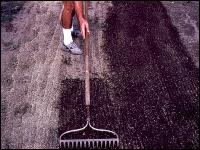
by Larry Williams | Apr 1, 2014
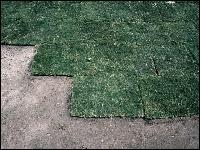
Sodding Lawn Photo Credit: UF/IFAS

Hand Raking Lawn Area Photo Credit: UF/IFAS
Cutting corners during lawn renovation usually results in poor turf establishment and long-term lawn maintenance problems.
Occasionally it is necessary to renovate a lawn or replant sections of a lawn. When replanting a lawn, it is best to not cut corners – you’ll usually pay for it in the long run. One of the most important factors is to prepare a good planting bed when renovating a lawn.
It doesn’t matter if you intend to re-sod, re-sprig or reseed; you need a level, loose and well-drained planting site for your lawn. A level lawn is much easier to mow. The loose soil allows for quicker root and runner establishment. Also, a well-drained site allows excess water to drain, preventing some disease problems.
One option is to spray the existing weeds and grass with a glyphosate herbicide such as Roundup. Allow the proper number of days for the weeds and grass to turn yellow (usually seven to 10 days).
Next, thoroughly till the area to a depth of 6 to 8 inches to loosen the soil.
Finally, level and smooth the planting bed, raking and then dragging (if needed) the bed. This can be done with a hand-rake and a hand-pulled drag such as a piece of chain-link fence on smaller areas. A tractor with rake and a grading box can be used on larger areas. A second option is to rent a sod cutter or remove the existing grass with a shovel before tilling and grading the site.
But whatever you do, don’t just lay new sod or broadcast grass seeds over a compacted, uneven, old lawn. There are just too many possibilities of having long-term and costly lawn problems as a result.
For additional information on establishing a Florida lawn, contact your local University of Florida Extension Office or visit http://hort.ufl.edu/yourfloridalawn.








